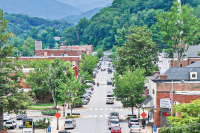Sylva finds it easy being green Solar panels and passive heating find their places in new police, fire stations
The Town of Sylva, in a quiet way, is busy setting a green example for its Western North Carolina neighbors.
First the fire department, and now the new police department, incorporate green, environmentally friendly components. Sylva’s police soon will take over the former library building on Main Street now that the library has moved to a new home on the hill alongside the historic courthouse.
There are a couple of common denominators in these two municipal green projects: town leaders who support these sorts of efforts and Sylva architect Odell Thompson.
“If you can tap into that, you should,” Thompson said. “We do want to do the right thing.”
Police Chief Davis Woodard is a convert, too, adding it’s important “to go as green as possible.”
Green strategies packaged with renovations to the old library include solar cells to augment the electrical system and a solar setup to heat water for showers. Solar tubes, a form of sky lights, will provide additional natural lighting. Some of the retrofitting includes adding insulation along the brick walls inside the old library.
Town council members last week approved $786,500 to fund the renovation. Interim Town Manager Mike Morgan said he believes the project will be ready to go out for bid next month.
The green elements are provided as alternatives in the bidding package, Thompson said.
“Up until the last possible second we can accept them or not,” he said.
If the cost comes in higher than the town wants to pay, it can opt to include the green features or trim them down.
The town’s new firehouse was completed a couple of years ago.
There are photovoltaic solar cells to convert the sun into electricity. To save on heating costs, hot water warmed by the sun’s rays flow through coils beneath the concrete slab in the garage bays where the trucks are parked, a form of passive, radiant heating. The slab retains heat because it has thermal mass, which helps keep temperatures warmer.
Up to eight sky lights, known these days as solar tubes, to bring in natural daylight. The building is south facing, and there’s an overhang to prevent heat buildup in summer and accept heat during the winter.
The men’s room has a waterless urinal to save on water use. Plus the building avoided the use of volatile organic compounds in the paints or carpet.
Architect wants ‘timeless’
Plans also call for a new look for the library façade on Sylva’s Main Street. The outside of the former public library is dated, even to the casual observer.
“Our goal is to make it look like a municipal building in a good sense,” Thompson said. “Secure, welcoming — not dated. This, now, is 1970s. We want something that is timeless.”
Architectural features from Sylva’s oldest building, the C.J. Harris building on Main Street that now houses Jackson General Store, provided ideas. The architect termed the creative borrowing as a way of “paying homage” to Sylva’s historic past. This includes a portico entrance, which as it sounds is a porch of sorts leading into the building, plus simplification of the roof canopy.
Inside, the police department will have women and men’s locker rooms, office space and a secure area for keeping evidence critical in criminal cases.
Outside and inside will be updated and modernized, Thompson said, adding that Chief Woodard brought a self-created lay-out for the interior space that worked with just some tweaking. Woodard said he collected ideas from visiting law enforcement facilities in Franklin, Maggie Valley and in Clay County. Plus, he said, his officers had ideas about what would make for an efficient workplace in the 6,400-square-foot building
For now, the 15-member town police, counting only fulltime employees, will continue to squeeze into the current police department on Allen Street next to town hall. The officers share just 1,000 square feet.
“We’ve been in that box too long,” Davis said.
Jackson County owned the old library building, but agreed to a property swap with the town last year. The county gave Sylva the old library building, and in exchange the town gave the county the former chamber of commerce building on Grindstaff Cove Road.
No jail cells will be built in the future police department. As takes place now, any prisoners detained by police will be taken to the county jail at the administration building.
Sylva police department expense breakdown
Architect and engineering: $36,000
Site work: $40,900
Construction: $561,120
Fixtures, furnishings and equipment: $76,800
Contingency: $71,680
Total: $786,500
Are cops making a pest of themselves in Maggie Valley?
Complaints from business owners and customers have Maggie Valley leaders asking if its police presence in the small tourist-oriented town is a bit overbearing.
Cruising along Soco Road — the single stripe along which Maggie Valley businesses have sprouted up — drivers are likely to see police cars camped out along the side of the road or in a parking lot.
While some find this fact comforting, other Maggie leaders and business owners argue that an overwhelming police presence in the valley deters possible consumers who fear that the cops are simply waiting to bust someone.
“There is a perception that it intimidates customers,” said Mayor Ron DeSimone during a meeting of Maggie leaders this month.
It is not just a perception; people are intimidated, chimed in Alderman Mike Matthews. Board members agreed, however, that cops mustn’t turn a blind eye and should enforce the law.
“Nobody is asking you to turn the cheek by any means,” Matthews said.
Although no one wants a lawbreaker to get away, some think that people shy away from Maggie Valley because they are afraid of being pulled over even if they are not speeding or driving drunk.
“They’ll be texting each other “Don’t go to Maggie. Don’t go to Maggie,’” Matthews said.
Chief Scott Sutton said he had not heard the same concerns. Visitors to the valley like to see cops out and about, patrolling the town, Sutton said.
“It don’t bother most people,” he said.
In fact, Sutton said, the police department will receive calls from a restaurant or a bar, asking the cops to show up around closing time to make sure the peace was kept.
“I can’t discourage my officers from doing their duties,” he said.
As far as drunken driving goes, DWI rates in Maggie are low, Sutton said. Most offenders are locals, he said. Others haven’t been out on the town in Maggie but are coming back from a show at Harrah’s Hotel and Casino in Cherokee.
Alderwoman Saralyn Price, the former town police chief, said that the officers are not picking on particular businesses but rather parking in a favorite spot or in the most convenient place.
“You are going to pull over in the easiest place,” Price said.
The aldermen and mayor made it clear that they, too, do not want the police to start shirking their responsibility, but DeSimone suggested that the town use some unmarked cop cars, which would allow police officers to continue to monitor the valley conspicuously.
“Nobody is complaining that you are pulling over people who are drunk or speeding,” DeSimone said. “We don’t want you to be less effective.”
The mayor also proposed fiddling with the police department’s patrol schedule, ensuring that a couple of cops are watching Soco Road while others make the rounds through residential areas — a circuit that takes 3 hours and 20 minutes to complete.
The aldermen said they brought the concern to Sutton after hearing complaints from business owners — but one alderman stated that the talk might not have not taken place if Maggie Valley businesses were not experiencing hardship as a result of the recession.
“If this was five years ago … then we wouldn’t be having this conversation,” Matthews said.
Like the town leaders, business owners had mixed feelings about the fuzz in Maggie Valley.
Steve Hurley, owner of Hurley’s Creekside Dining & Rhum Bar, said he has not heard any patrons protest about the number of patrol cars along Soco Road.
“It’s never affected me,” Hurley said. “I like having the cops around. I want them to be getting the drunk drivers.”
In regards to officers parking their vehicles near his business, Hurley replied that they have to park somewhere.
In contrast, a co-owner of Stingray’s said it is a chronic problem.
“Here is the feedback we hear: we don’t want to come to Maggie Valley because all the law does is sit around and wait on us,” said Nathan Hughes, Stingray’s owner. “That kills business. People get intimidated by that.”
The police need to find a happy medium, in which they continue to keep people safe but avoid scaring off potential customers, Hughes said.
Maggie has historically had an active bar scene. It was one of the first and only towns where liquor drinks were legal at bars. For nearly two decades, it was one of the only WNC towns west of Asheville where mixed drinks were sold, and revelers would bring their partying to Maggie as a result, setting a precedent of an active after-hours police presence.
Police beating in Bryson City leads to $22,500 settlement
A mentally ill man got a $22,500 settlement in a lawsuit against a Bryson City police officer who hit him multiple times with a baton and sprayed him with pepper spray.
The settlement came more than three years after the incident, which involved a 25-year-old with schizophrenia. The man sustained physical injuries and mental trauma after a Bryson City police officer hit the man repeatedly with a baton while serving involuntary commitment papers on him outside a downtown pizza restaurant.
The out-of-court settlement was reached through mediation in November.
The settlement is being paid by the town’s insurance company and not out of town coffers. In fact, the town didn’t even know it had been settled, said Bryson Town Manager Larry Callicutt.
Callicutt said he found out last week that the case had been settled by the insurance company back in November.
The suit by Jacob Grant claimed Bryson City Police Office Leon Allen sprayed him with pepper spray and hit him on the head, face, shoulders, stomach, back and legs, even after he was already on the ground. Grant’s family had petitioned for involuntary commitment because they feared Grant was not taking his medication.
When Allen tried to take Grant into custody, Grant asked to see the commitment papers, Allen couldn’t produce them, and a verbal argument ensued that allegedly escalated into Allen beating Grant. Ten witnesses stepped forward and filed police brutality complaints against Allen.
Allen, meanwhile, claimed Grant assaulted him. Grant was charged with assaulting an officer but those charges were dropped when Grant agreed to plead guilt to the lesser charge of obstruction of justice.
Allen was placed on leave while the department conducted an internal investigation, but was eventually reinstated on the force. He later left the Bryson police department and went to work in another county.
The settlement was signed on Bryson City’s behalf by Attorney Sean Perrin with Womble and Carlyle law firm out of Charlotte, who specializes in liability claims against police departments. The insurance company hired and paid for the attorney.
Grant was represented by Asheville attorney Andrew Banzhoff. The civil suit was filed almost two years after the incident, just shy of the statute of limitations cut-off.
Banzhoff said he could not discuss the settlement due to confidentiality provisions.
Clyde’s top cop sidelined on suspension
Clyde’s police chief has been placed on suspension, but town leaders are not saying why.
Police Chief Derek Dendy is currently on a 30-day unpaid suspension, with the possibility of further action pending the outcome of a hearing in two weeks. Clyde Town Administrator Joy Garland cited state personnel laws as preventing the town from discussing the reasons for the suspension. Dendy has been a police officer for the town of just more than 1,300 since September 1998. He was promoted to chief in 2008.
Mayor Jerry Walker said a pre-disciplinary hearing for Dendy is set for Jan. 9 at 2 p.m. with the five-member town board. This hearing presumably affords Dendy the opportunity to respond to further disciplinary action being considered by the board.
Walker noted town leaders opted for an unpaid suspension because otherwise, the mayor said, “it’s just a month-long vacation.”
Sylva crunching budget to pay for police department move
Renovating the old library on Main Street in Sylva for a new police department is on something of a hiatus until a new town board convenes.
The town board will get a new member following this month’s elections. Lynda Sossoman will replace current town Commissioner Ray Lewis. Sossoman said Monday that she fully supports the renovation of the old library for a town police department.
Town leaders must identify where the estimated $700,000 needed for the job will come from, interim Town Manager Mike Morgan said.
“The next thing we would want is to get an architect to do detailed plans — but (commissioners) are not there, yet,” he said.
Until then, the 15-member town police — counting only fulltime employees — will continue to squeeze into the current police department on Allen Street. The officers share just 1,000 square feet. The old library is 6,400 square feet in size.
Jackson County owned the old library, but agreed to a property swap at the town’s request earlier this year. The county gave Sylva the old library building on Main Street, and in exchange the town gave the county the former chamber of commerce building on Grindstaff Cove Road.
As takes place currently, any prisoners detained by police will be transported immediately to the county jail at the administration building instead of being held at the police department.
Sylva merchants have repeatedly requested a greater presence by town police on Main Street. In addition to the prospect of having the department located physically there, a new police officer was recently assigned to foot patrols downtown.
Too fancy or just right?
Waynesville has spent $7 million over the past four years building a new fire station, police station and town offices — projects that have come under fire by some challengers for the town board.
Opponents point to the architecture — the brick towers on the fire house, the wood timber frames over the police department entrance — and question how much they added to the price tag.
“I think it is a little extravagant,” said Hugh Phillips, who is running for mayor.
“They may be just a bit more than we really needed,” said candidate Sam Edwards, calling the buildings too fancy. “It certainly helped prettify things, but I don’t know if that was what we should be doing right now.”
But the incumbents say the attractive building design added little to the cost and was worth it.
“I am proud of those things, and if they want to rag on me for that, guilty as charged,” said Waynesville Mayor Gavin Brown.
Mary Ann Enloe, a challenger in the race, lauded the buildings and doesn’t consider them extravagant.
“I think the designs are beautiful,” Enloe said. “Why didn’t we make the justice center look like that?”
Alderman Gary Caldwell said the town actually scaled back some elements of the building design.
“It could have been far more fancy than what it is now,” Caldwell said.
The new police department on Main Street also houses the town planning office where developers and entrepreneurs come for their building permits and business licenses. It was important for it to look nice, Brown said.
“You are trying to create atmosphere when they come in to town they are impressed, that they are in a progressive arena, a place where people are doing things,” Brown said.
Criticism of the town building projects has originated from a political action committee called the Waynesville-Haywood Concerned Citizens. A web site by the group cites the “ostentatious” police department and “extravagant” fire station.
The web site questions a few others town spending priorities as well, but one of the chief examples is inaccurate. It blasts the town for spending money on fancy downtown art. However, no town tax dollars went for the public art pieces. They were funded entirely with private donations.
Sylva police department to find new home on Main Street
A dire space crunch for Sylva’s police officers has been solved.
Jackson County will give the old library building on Main Street to the town for a new police department. In return, Sylva will give the county the former chamber of commerce building on Grindstaff Cove Road.
“One hand washes the other,” Commissioner Charles Elder said in summing up the deal. “Maybe some people will think we are giving too much for a lot less from the town, but it’s not just for (Sylva’s) benefit.”
The old public library has an appraised tax value of $796,000; the former chamber of commerce building was valued at $157,560. County commissioners met with town board members Monday to discuss the trade and voted unanimously to make the deal. Commissioner Joe Cowan was absent.
Town police are strapped for space in the current police department on Allen Street. Fourteen full-time officers (soon to be 15) and three auxiliary officers share just 1,000 square feet. The old library is 6,400 square feet in size.
“We’re not trading apples for apples, I recognize that,” Commissioner Mark Jones said before endorsing the deal as ultimately beneficial to both parties involved. “Let’s help each other out.”
Commissioner Doug Cody said he had some reservations, primarily because he’d prefer to see more retail business on Main Street.
“But I think we can probably work things out since we don’t have anyone beating our doors down to get that building,” Cody said.
County Manager Chuck Wooten confirmed Jackson County hasn’t received any inquiries from anyone interested in buying the old building. The library in June moved to a new location at the historic courthouse overlooking Main Street.
“We need the space, bad,” said Harold Hensley, a Sylva town council member, who added that the swap would also be good for the town and county’s overall relationship.
Chris Matheson, a former district attorney who sits on the town board, confirmed that prisoners would not be detained in that building. As takes place currently, any prisoners detained by police will be transported immediately to the county jail at the administration building, she said.
Matheson said Sylva merchants have repeatedly requested a greater presence on Main Street by town police. In addition to the prospect of now having the department located physically there, council members also decided recently to hire a new police officer assigned to foot patrols downtown.
Town Manager Adrienne Isenhower, in a follow-up interview after the workshop, said there are already rough blueprints drafted for how the new police department would be built. She said the town’s public works department, also currently strapped for space, would probably move into the vacated police department.
Police Chief Davis Woodard described he and his officers as “just tickled,” and emphasized his gratitude for the united backing of town commissioners in helping the police department gain more space.
Sylva police packed in like sardines
Just stepping inside the Sylva Police Department gives a person an immediate understanding of why Chief Davis Woodard is pushing so hard for a new building.
The department’s 14 officers, with one more being hired soon, and its three auxiliary officers share 1,000 square feet of room in the 1927-completed building, located on Allen Street. The building was originally designed and built for the town’s fire department; the police department started using it in 1990.
To describe the Sylva Police Department as rather crowded is akin to describing Sylva’s newly renovated historic courthouse and library complex as merely pretty. The words fall short of the reality.
The town’s police officers are crammed into the equivalent of five to seven standard parking spaces.
A few highlights include:
The women’s bathroom at the police department was recently sacrificed to create a tiny break room; all officers now share what had been the men’s bathroom.
Evidence is stored in three different areas; only one of which is actually in the police department. One of the evidence rooms, down in the basement of the building, sometimes floods when bordering Scotts Creek jumps its banks.
There is little to no room left, anywhere, for storing any additional items critical to any successful police investigation. This means when the State Bureau of Investigation finishes up lab work on evidence from a recent double homicide in Sylva, Woodard needs the town’s maintenance crew to construct some kind of special holding place to hold the dozens of items that will be sent to Sylva in anticipation of a trial. Who knows what the officers will do if another big case takes place anytime soon within the town’s limits.
A weight room or workout area, common to most police departments in the region in hopes officers will keep in shape, is simply out of the question. A Bowflex machine is gathering dust in storage at the back of town hall.
Full-sized personal lockers for the officers are also impossible given the space limitations — Woodard jokes about the “preschool”-sized ones in use now, quipping that he’d like his officers to have big-boy and big-girl lockers instead.
The first door to the left in the Sylva police department opens into a 20-x-18 square foot room used by the assistant police chief, four patrol supervisors and seven road officers. Lt. George Lamphiear said the scene is particularly chaotic during shift changes, with everyone jockeying for a place to work. Or in the middle of a huge case such as the double homicide, when the building had to host an additional four or five SBI agents, the district attorney and three or four of his assistants.
“We came into work (that day), and turned right around and went back out,” Lamphiear said. There was no room left for patrol officers and their supervisors to work in the building.
The department also has a small office for the police chief, a slightly larger office for the department’s two detectives, and a tiny reception area at the front. A couple of storage closets, and that’s it.
No interview room, no conference room and inadequate parking in the back, to boot.
If the Sylva Police Department does acquire the old library, Woodard and his officers will have, in place of 1,000 square feet, an airy 6,400 square feet at their disposal, plus 19 parking spaces.
Sounds like heaven on earth to Woodard and his officers.
The situation
Sylva’s council members have asked Jackson County to give the them the old library building on Main Street, now standing vacant, to use as a police department. County commissioners agreed last week to meet with their town counterparts on July 18 to discuss it. Sylva is offering, in return for the old library building, to give Jackson County the old chamber of commerce building it owns, a small building on Grindstaff Cove on the approach to downtown.
The sticking point, if there is one, might involve the disparate tax values of the two buildings involved. Sylva’s building is valued at $157,560; the county’s building is $796,000.
Town leaders, however, have described the swap as an issue of fairness, noting that in past years they have allowed the county to use town-owned buildings, such as the senior center, for no charge to taxpayers, or at nominal lease amounts such as $1 a year.
Sylva makes bid to Jackson leaders for old library
Sylva leaders want their Jackson County counterparts to lease, for $1 a year, the old library building to them, citing space needs and a heightened Main Street presence for the town’s police department.
The Sylva library is in the process of moving to a building beside the newly renovated, historic Jackson County courthouse. The grand opening is set for next month. This comes as Sylva’s 15-member police department jockeys for space in 1,000 square feet the town can allot to it. The Sylva Police Department is next to town hall on Allen Street, several blocks from the downtown.
Lack of space “makes it very difficult to investigate cases, interview witnesses and interrogate suspects,” town board member Chris Matheson, a former assistant district attorney, told county commissioners at a meeting this week. “It is imperative at this point we try to find a location for them.”
County Commission Chairman Jack Debnam said they’d consider discussing the town’s request during a budget work session next week.
The town has eyed the former public library for a police department at least since the spring of 2009. Then Police Chief Jeff Jamison contacted then County Manager Ken Westmoreland at the town board’s request. Westmoreland told Jamison the county would be willing to sell or lease the building, but didn’t specify the town’s cost for either of those options.
That was then, and this is now: Jamison is gone, Westmoreland is gone, and a new majority of commissioners took control in last November’s election. It’s unclear what they want to do with the old library building, if they even know, at this juncture, themselves.
Matheson characterized the town’s desire for the centrally located building as something of an “equity issue.” She pointed out Sylva shares 50 percent of its ABC revenues with the county. A vast number of cases investigated by the town police involve people who have been drinking alcoholic beverages, Matheson said.
ABC dollars totaled $139,890 this year alone in revenue gains for Jackson County.
“What have we done that makes Sylva want to be so good to us?” Commissioner Joe Coward asked Matheson about the town’s willingness to share the ABC wealth.
The councilmember responded she believes Sylva simply didn’t — at least initially when it agreed to share the wealth — realize how significant the revenue stream would prove. After voters approved the sale of mixed drinks at bars and restaurants in a 2005 referendum, sales at the Sylva ABC store went up more than 40 percent.
This 50-50 split between a town and county is an unusual arrangement, Matheson said, and is mirrored by just five or so other municipalities in North Carolina.
Franklin keeps 100 percent of its ABC revenues; Bryson City keeps 90 percent and specifies the remaining 10 percent go to parks and recreation; Waynesville keeps 64 percent and gives 18 percent to the schools, and the remaining 18 percent is funneled into Haywood County’s general fund.
Matheson, drawing on her legal skills to weave a persuasive sticky web commissioners might find difficulty disentangling from, continued gently but firmly pressing for the coveted downtown space. She pointed out that Sylva officials were kind enough to rent to Jackson County a town-owned building for use as a senior-citizen facility — $1 a year for 15 years, and before that, for free. And, additionally, the town provided a building to house the chamber of commerce — again, Matheson noted, free of cost to the county.
What the town offers in return for the old library building, Matheson said in summation during her closing argument, is an opportunity to protect and serve all the residents of Jackson County who come, in large part, to conduct the county’s business in Sylva. And that could best happen if the space-crunched police department is in the old library; for, she said, a nominal fee a year accompanied by a long-term lease consisting of at least 25 years. And the town will even pay for renovations and repairs, which she estimated could total $150,000, Matheson said, adding a possible enticing carrot.
County commissioners thanked the town board member for her presentation, but did not commit one way or another to her request.
Carl Iobst, a regular member of the public at county meetings, told commissioners during the public-comment session that he wants the town to reimburse the county “a fair and reasonable amount” for the building, saying in these fiscally trying times, $1 a year is too little an amount for such a prize.
Tribal police struggle to communicate in outlying areas
In the farthest reaches of the Cherokee Indian Reservation, work is being done to ensure that when crime happens, the police can be there.
While most portions of the reservation are central to Cherokee itself, within easy reach of police officers and their radio systems, the slivers of tribal land that lie unattached to the main reservation are a far larger challenge to law enforcement officials.
At issue here is the police department’s radio system, which, according to Cherokee Indian Police Chief Ben Reed, is just not strong enough to reach into the Snowbird community in Graham County or the Cherokee County portions of tribal property.
Sometimes this causes problems and sometimes it doesn’t, but it’s something Reed said his department is actively looking into.
“Due to the mountainous terrain, it does create issues for us to develop a radio communications system that would reach 45 miles away or 60 miles away,” said Reed. “It’s very difficult to do.”
And while this doesn’t necessarily keep officers from answering calls, it does make communication between the police department and its officers in the outlying regions more difficult and time consuming.
Reed said that his department works closely with the sheriff offices of both counties, who allow the tribal cops to use their radio systems whenever it’s necessary. But calls don’t always come into the local counties’ 911 dispatches; sometimes, they’re called straight into the Cherokee dispatch center, which makes contacting an officer in Graham and Cherokee counties onerous.
Reed said that he and the other emergency response agencies are now putting together a task force to address that very issue, and hopefully they’ll be able to come up with some solutions as early as the end of next week.
“We’re going to figure out, you know, what are our options,” said Reed. “We need to get all these things in place and see where we’re at and is it even possible?”
Whether that means erecting new towers or getting newer, more powerful radio systems for outlying officers, Reed said he’s confident they can find solutions to the problem. The real issue, however, is funding those solutions.
“That’s probably going to take a lot of funding, and where’s the funding going to come from?” Reed said. “We can search for grants and lobby for more funding through our current resources, but there’s a lot of work to be done.”
Meanwhile, the community is calling for a fix to the police communication problems that they see on the ground in the outer counties.
At a special tribal council meeting last month called specifically to address concerns of law and order on the Qualla Boundary, several residents lamented the slow response times to the more remote communities.
“When we talk about the jurisdiction of the land, the Qualla Boundary, it’s not just here on the main which has Jackson and Swain counties, but you’ve got Graham County and you also have Cherokee County,” said Cherokee resident Missy Crowe. “I’ve heard from the brothers and sisters way down in Cherokee County that they would call the police and they’d be lucky if they’d get an officer to respond to them.”
Reed said that, while they do have substations in both counties and six officers assigned to them — four in Snowbird and two in Cherokee County — he knows that more officers can always make things better.
“You can never have enough police officers, and although the calls are minimal in those areas, we still have to provide the community with sufficient resources to serve that population there,” said Reed, adding that his department has worked with those two communities over the last several years to identify just what residents want and need from law enforcement.
But when it comes to actually improving on-the-ground radio communication and coverage for remote communities, Reed said it’s just not something he and his officers can tackle alone.
Reed and his department are overseen by a police commission appointed by tribal council. And while he said he welcomes the oversight and needs the help, it’s no secret that the department and the commission have been at odds in recent months about the commission’s role and relationship to the police.
At last month’s meeting, Reed and members of the police commission had vocal disagreements about the commission’s actions, with Reed taking the position that commissioners were homing in on petty and restrictive issues while ignoring the bigger problems at hand. Radio communications, he said, were one of those concerns, and he reiterated that stance in an interview.
“That’s where we need help,” said Reed. “Those kind of issues aren’t easy. That’s not something that we can just look at tomorrow and say we need A, B and C done and just knock it out.”
He didn’t say whether the commission had been approached for involvement in the process, but noted that improving their radio signals was an important proactive step in the tribe’s crime-fighting approach.
“We’ve not had any major issues with it,” said Reed, “but we shouldn’t sit round and wait on a major issue to happen.”









